Federal, Unitary, and Confederal Systems Explained
Why It’s Worth It
Gain a comprehensive understanding of how different government systems operate and impact society.
Enhance your critical thinking skills by analyzing the strengths and weaknesses of each system.
Prepare for real-world political discussions with in-depth knowledge and contemporary case examples.
Your Learning Roadmap
Introduction to Government Structures
This module introduces the three primary forms of government organization – federal, unitary, and confederal systems. Learners will understand basic definitions, historical evolution, and their significance in modern governance. This foundation sets the stage for in-depth analysis in subsequent modules. Overview of Political Systems Importance of Power Distribution Historical Evolution of Government Models
Foundations of Federal Systems
This module delves into the characteristics of federal systems, focusing on power sharing between central and regional authorities. Learners will discover how federalism operates through decentralization and the benefits such as local autonomy. Challenges including conflicts and coordination issues will be contrasted against its advantages. Defining Federalism Structure and Functionality Advantages and Challenges
Exploring Unitary Systems
This module clarifies how unitary systems centralize authority in a single, sovereign government. It will explore how decisions are uniformly applied across the state and the impact this has on policy implementation. Learners will delve into the benefits of streamlined governance, while also critiquing potential pitfalls related to regional underrepresentation. Characteristics of Unitary Systems Pros and Cons of Centralized Power Case Examples of Unitary States
Understanding Confederal Systems
This module explains confederal systems where regions or states retain significant sovereignty while collaborating on common interests. It highlights the balance between the independence of member states and the efficacy of a central authority. Through historical examples, learners will critically evaluate the flexibility and challenges unique to confederations. Defining Confederalism Mechanisms of Cooperation Strengths and Limitations
Comparative Analysis and Frameworks
This module brings together learned concepts and enables comparative analysis across different government systems. Learners will use frameworks discussed in key texts to critically analyze the strengths and weaknesses of each system. The module also offers tools to evaluate which system is appropriate under given circumstances, with emphasis on real-world applications. Comparative Frameworks in Governance Critical Comparison of Systems Integrating Theoretical Perspectives
Case Studies and Contemporary Issues
This final module applies theoretical insights to contemporary political environments. Learners will examine case studies from various countries, understanding how different government structures cope with modern challenges. This module encourages critical thinking about future trends in governance and the evolution of state structures. Modern Case Studies Contemporary Challenges Future of Government Structures
What Users Are Saying
All You Need to Know
Enroll Now for Insight!
Engage in real-time discussions to enhance comprehension.
Learn at your own pace with chat-based modules.
Receive instant feedback on your questions.
Explore practical case studies from various countries.
Access a balanced view of each system's advantages and challenges.
Apply analytical frameworks to assess governance structures.

